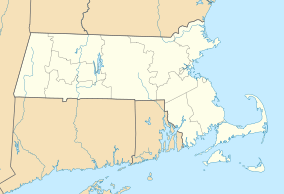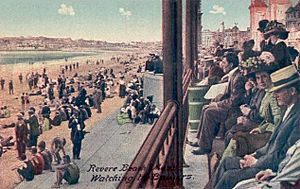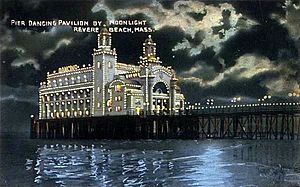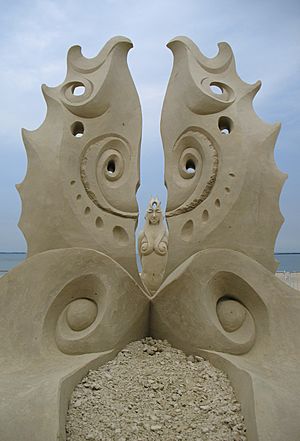Revere Beach facts for kids
Quick facts for kids Revere Beach Reservation |
|
|---|---|
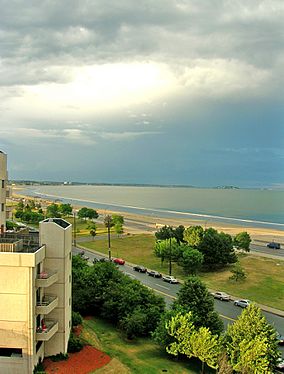
Revere Beach in 2005
|
|
| Location | Suffolk, Massachusetts, U.S. |
| Area | 84 acres (34 ha) |
| Elevation | 10 ft (3.0 m) |
| Established | 1896 |
| Operator | Massachusetts Department of Conservation and Recreation |
| Website | Revere Beach Reservation |
|
Revere Beach Reservation
|
|
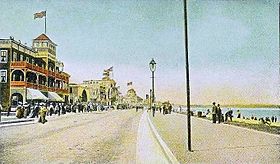
Revere Beach Blvd. in c. 1910
|
|
| Location | Revere, Massachusetts |
| Built | 1895 |
| Architect | Charles Eliot; William D. Austin of Stickney & Austin |
| NRHP reference No. | 03000642, 98000871 |
| Significant dates | |
| Added to NRHP | May 27, 2003 |
| Designated NHL | May 27, 2003 |
Revere Beach is a popular public beach in Revere, Massachusetts. It is located about 5 miles (8 km) north of downtown Boston. The beach stretches for over 3 miles (5 km) along the coast.
In 1875, a train line was built to the beach. This made it very easy for people to visit. Because of this, Revere Beach became a popular summer spot. In 1896, it made history by becoming the very first public beach in the United States.
Today, you can still easily reach Revere Beach by the MBTA Blue Line from Boston. It is so popular that it can welcome up to one million visitors in a single weekend. This often happens during its yearly sand sculpture competition.
Contents
History of Revere Beach
Early Days and Growth
In the 1620s, European settlers first explored this area. Within ten years, it became a busy farming community. Later, it was added to Chelsea, Massachusetts from Boston. At that time, the area was known as Chelsea Beach.
In 1875, the Boston, Revere Beach & Lynn Railroad arrived. This train was called the "Narrow Gauge." It made Chelsea Beach easy to reach for visitors from Boston and other places. Many buildings for fun and recreation appeared along the beach. These buildings were very close to the high tide line. A few years later, in 1881, local people voted to change the beach's name to Crescent Beach.
America's First Public Beach
In 1896, the Metropolitan Park Commission took control of the beach. This group is now part of the Massachusetts Department of Conservation and Recreation. They followed a plan by landscape architect Charles Eliot. The train tracks were moved away from the beach. They now follow the path used by the MBTA Blue Line. More than 100 buildings were also removed from the beach itself.
On July 12, 1896, Revere Beach officially opened as the first public beach in the nation. About 45,000 people came on opening day! Just a few weeks later, tens of thousands more rushed to the beach to escape a very hot summer.
In the years that followed, Revere Beach added many exciting attractions. These included restaurants, places to dance, roller skating rinks, bowling alleys, and roller coasters. Three roller coasters were especially famous. The Cyclone was a wooden roller coaster built in 1925. It was the tallest roller coaster ever built at that time. The Lightning was another wooden roller coaster. The Derby Racer was a racing roller coaster. All of these exciting rides have since been taken down.
A Big Event in 1920
On the night of August 8, 1920, a large disturbance happened at Revere Beach. It started when a police officer arrested a United States Navy sailor. Other sailors nearby tried to help their friend. Soon, many servicemen, including Marines and United States Army soldiers, joined in. They surrounded the police station. About 400 people threw rocks and fired toy guns at the station.
Help was called from nearby military bases and the Chelsea Police Department. About 200 Army soldiers arrived and helped the police clear the beach. More than 100 people were arrested. By August 9, the situation was finally under control. Some police officers and civilians had minor injuries from flying stones. The police station's windows were broken, and much of its furniture was damaged.
Decline and Rebirth
The popularity of Revere Beach started to fade in the 1950s. The buildings and facilities at the beach began to get old and worn out. In February 1978, a very large blizzard hit. It destroyed many of the remaining buildings, the sidewalks, and the sea wall.
After a lot of hard work by the city of Revere and the state of Massachusetts, the beach was reopened in May 1992. On July 19, 1996, Revere celebrated 100 years since the beach first opened. It was a three-day party! On May 27, 2003, Revere Beach was named a National Historic Landmark. This means it is a very important historical place. In 2007, Revere Beach Boulevard was updated with new plants, sidewalks, and better parking.
New England Sand Sculpting Festival
The New England Sand Sculpting Festival has been held at Revere Beach every July since 2004. During the festival, a part of the beach is fenced off. This creates a temporary art gallery for everyone to enjoy. The people who organize the event say it is the biggest sand-sculpting contest in New England. In 2010, artists competed for $15,000 in prize money. This yearly contest brings about one million visitors to the beach.
Water Quality at the Beach
Since the BEACH Act was passed in 2000, a big effort has been made to make the water at Revere Beach cleaner. This also applies to other beaches in Massachusetts. There is a public website that shows water quality results. It also tells people if a beach is closed because of germs in the water.
Revere Beach is regularly checked for a type of bacteria called Enterococcus. This bacteria can cause illnesses like a sore throat or stomach problems. The water is tested every week during the summer, from June to August. These tests happen at four different spots: Oak Island, Revere Beach Bathhouse (state police station), Beach Street, and Point of Pines. The Massachusetts Water Resources Authority collects all this important information.
Wildlife at Revere Beach
Piping plovers are an endangered species of bird. They are known to build their nests along Revere Beach in the Spring. During the time when these birds are nesting, fences are put up. These fences help protect the birds and their tiny eggs. The eggs are so small that they blend in with the sand!


